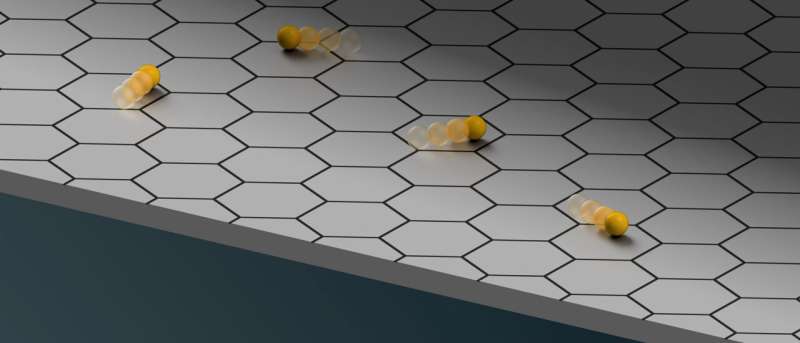Illustration of hardcore bosons confined to a two-dimensional plane. Credit: MPI-FKF
Three-dimensional (3D) antiferromagnets are materials in which magnetic moments of atoms or ions are arranged in a 3D lattice structure with neighboring spins aligned in opposite directions. Physicists have observed a fascinating magnetic field–induced phase transition in these materials, described at magnon Bose-Einstein condensation (BEC).
While in 2D systems this transition cannot occur, quasi-2D systems might still exhibit some BEC behavior, along with predominantly 2D physical processes. Some studies have reported this behavior in a few quasi-2D materials, yet only at very high magnetic fields that are difficult to access in laboratory settings.
Researchers at the Max Planck Institute for Solid State Research, University of Stuttgart and University of Tokyo recently observed fascinating 2D-limit BEC behavior in the quasi-2D antiferromagnet YbCl3 at a relatively low magnetic field.
Their paper, published in Nature Physics, specifically reports the observation of a quantum critical Bose gas of magnons in this material.
"Originally, we were searching for new candidates of Kitaev quantum spin liquid materials," Yosuke Matsumoto, co-author of the paper, told Phys.org. "The material we study here, YbCl3, is a pseudospin-1/2 quantum magnet on a honeycomb lattice, for which a possible realization of Kitaev quantum spin liquid has been suggested theoretically. Inspired by this, we initiated our research."
"Soon after they started exploring that the possibility that YbCl3 could be a Kitaev quantum spin liquid, two research groups in the United States found that the rare earth chloride has no chance. In fact, the first team at UCLA found evidence of a magnetic ordering, rather than a quantum spin liquid state. The second group at Oak Ridge observed that magnetic excitation measured by inelastic neutron scattering can be described extremely well as a conventional Heisenberg magnet rather than a Kitaev magnet."
"Nevertheless, we focused on the fact that this magnetic ordering is suppressed at a saturation field of approximately 6 T, forming a quantum critical point," Matsumoto said. "We discovered that this quantum critical point provides a rare example of a BEC quantum critical point in the two-dimensional limit."
As part of their latest study, Matsumoto and his colleagues analyzed pure single crystals of YbCl3. They collected a series of high-precision measurements assessing the specific heat, magnetization and thermal conductivity of these crystals at very low temperatures (i.e., down to a few tens of millikelvins).
"We discovered that the temperature dependence of the specific heat and magnetization near the saturation field of approximately 6 T aligns perfectly with theoretical predictions for a BEC quantum critical point in the two-dimensional limit," Matsumoto explained.
"In this way, through the characterization of this quantum critical point, we revealed that the magnetic fields below and above this quantum critical point correspond to a state where finite hard-core bosons undergo BEC (the magnetic ordered state) and a vacuum state with no bosons (the fully polarized state), respectively."
The researchers observed the formation of a quantum critical 2D Bose gas in their YbCl3 sample, which appeared to go through BEC. Their study offers the first experimental demonstration of quantum critical processes involving 2D hard-core bosons, demonstrating their behavior as a dilute gas.
"We also successfully demonstrated that the effective boson–boson repulsion significantly reduces in the dilute limit due to the logarithmic correction inherent in 2D systems," Matsumoto said.
"From a theoretical point of view, these behaviors have been known for many years. However, the lack of suitable materials has prevented us from demonstrating such fundamental properties of bosons in 2D until now."
The findings gathered by Matsumoto and his collaborators confirm that the YbCl3, previously hypothesized to be a Kitaev quantum spin liquid, is instead a promising platform to realize quantum critical BEC in the 2D limit. In the future, this realization could pave the way for new studies focusing on this material and its underlying physics.
"In a true two-dimensional system, a BEC is not expected; instead, a BKT transition, characterized by the dissociation of vortex pairs, is anticipated," Matsumoto added. "Our study revealed that the magnetic ordering just below the saturation field can be viewed as a BEC stabilized by extremely small interlayer coupling, but a situation very close to a BKT transition is still possible.
"Exploring such possibilities, particularly looking for signs of vortex excitations and other novel states characteristic of two dimensions, will be an important objective of our future works."
More information: Yosuke Matsumoto et al, A quantum critical Bose gas of magnons in the quasi-two-dimensional antiferromagnet YbCl3 under magnetic fields, Nature Physics (2024). DOI: 10.1038/s41567-024-02498-w
Journal information: Nature Physics
© 2024 Science X Network
























